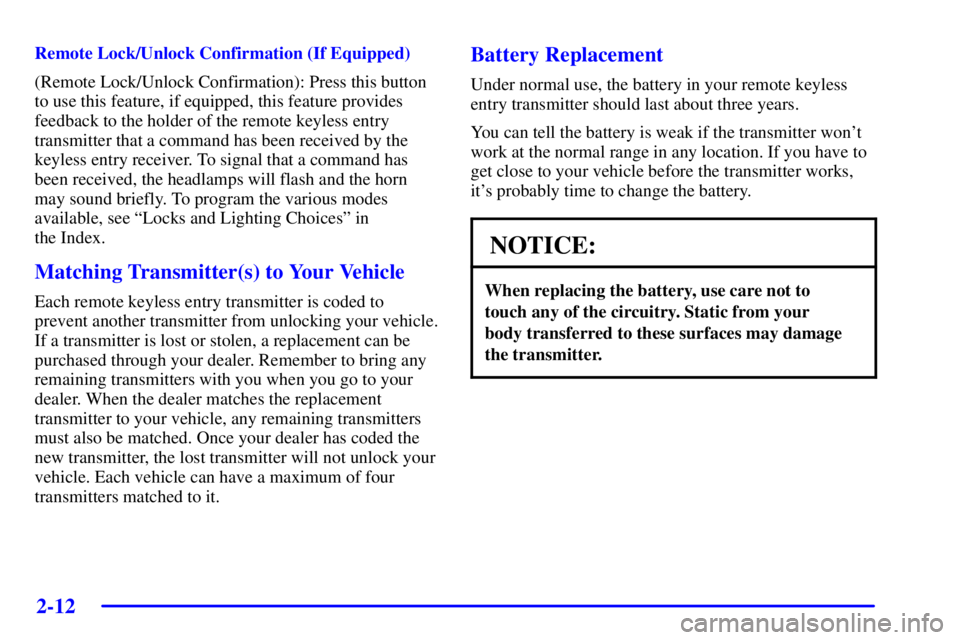Page 70 of 374

2-10
Remote Keyless Entry System
(If Equipped)
If your vehicle has this feature, you can lock and unlock
your doors or unlock your trunk from about 3 feet (1 m)
up to 30 feet (9 m) away using the remote keyless entry
transmitter supplied with your vehicle.
Your keyless entry system operates on a radio frequency
subject to Federal Communications Commission (FCC)
Rules and with Industry Canada.
This device complies with Part 15 of the FCC Rules.
Operation is subject to the following two conditions:
(1) this device may not cause harmful interference,
and (2) this device must accept any interference
received, including interference that may cause
undesired operation.
This device complies with RSS
-210 of Industry Canada.
Operation is subject to the following two conditions:
(1) this device may not cause interference, and (2) this
device must accept any interference received, including
interference that may cause undesired operation of
the device.Changes or modifications to this system by other than an
authorized service facility could void authorization to
use this equipment.
At times you may notice a decrease in range. This is
normal for any remote keyless entry system. If the
transmitter does not work or if you have to stand closer
to your vehicle for the transmitter to work, try this:
�Check the distance. You may be too far from your
vehicle. You may need to stand closer during rainy
or snowy weather.
�Check the location. Other vehicles or objects may be
blocking the signal. Take a few steps to the left or
right, hold the transmitter higher, and try again.
�Check to determine if battery replacement is
necessary. See the instructions that follow.
�If you're still having trouble, see your dealer or a
qualified technician for service.
Page 72 of 374

2-12
Remote Lock/Unlock Confirmation (If Equipped)
(Remote Lock/Unlock Confirmation): Press this button
to use this feature, if equipped, this feature provides
feedback to the holder of the remote keyless entry
transmitter that a command has been received by the
keyless entry receiver. To signal that a command has
been received, the headlamps will flash and the horn
may sound briefly. To program the various modes
available, see ªLocks and Lighting Choicesº in
the Index.
Matching Transmitter(s) to Your Vehicle
Each remote keyless entry transmitter is coded to
prevent another transmitter from unlocking your vehicle.
If a transmitter is lost or stolen, a replacement can be
purchased through your dealer. Remember to bring any
remaining transmitters with you when you go to your
dealer. When the dealer matches the replacement
transmitter to your vehicle, any remaining transmitters
must also be matched. Once your dealer has coded the
new transmitter, the lost transmitter will not unlock your
vehicle. Each vehicle can have a maximum of four
transmitters matched to it.
Battery Replacement
Under normal use, the battery in your remote keyless
entry transmitter should last about three years.
You can tell the battery is weak if the transmitter won't
work at the normal range in any location. If you have to
get close to your vehicle before the transmitter works,
it's probably time to change the battery.
NOTICE:
When replacing the battery, use care not to
touch any of the circuitry. Static from your
body transferred to these surfaces may damage
the transmitter.
Page 229 of 374
5-5
4. Open the hoods and locate the batteries. Find the
positive (+) and negative (
-) terminal locations on
each vehicle. You will not need to access your
battery for jump starting. Your vehicle has a remote
positive (+) jump starting terminal for that purpose.
The terminal is located in the engine compartment
on the passenger's side of the vehicle, near the
diagonal cross brace. See ªEngine Compartment
Overviewº in the Index for more information
on location.
To uncover the remote positive (+) terminal, squeeze
the sides of the plastic cap and slide the cap off. You
should always use the remote positive (+) terminal
instead of the positive (+) terminal on the battery.
Page 231 of 374
5-7
Before you connect the cables, here are some basic
things you should know. Positive (+) will go to
positive (+) or to a remote positive (+) terminal if the
vehicle has one. Negative will go to a heavy, unpainted
metal engine part or to a remote negative (
-) terminal
if the vehicle has one.
Don't connect positive (+) to negative (
-), or you'll
get a short that would damage the battery and maybe
other parts, too. And don't connect the negative (
-)
cable to the negative (
-) terminal on the dead battery
because this can cause sparks.
6. Connect the red positive (+) cable to the positive (+)
terminal location on the vehicle with the dead
battery. Use a remote positive (+) terminal if the
vehicle has one.
Page 232 of 374
5-8
7. Don't let the other end
touch metal. Connect it
to the positive (+)
terminal location on the
vehicle with the good
battery. Use a remote
positive (+) terminal if
the vehicle has one.8. Now connect the black
negative (
-) cable to
the negative (
-)
terminal location on
the vehicle with the
good battery. Use a
remote negative (
-)
terminal if the vehicle
has one.
Don't let the other end touch anything until the next
step. The other end of the negative (
-) cable doesn't go
to the dead battery. It goes to a heavy, unpainted metal
part or to a remote negative (
-) terminal on the vehicle
with the dead battery.
Page 243 of 374
5-19 How to Add Coolant to the Radiator
NOTICE:
Your engine has a specific radiator fill procedure.
Failure to follow this procedure could cause your
engine to overheat and be severely damaged.
The radiator pressure cap is located on the passenger's side
of the vehicle in the front of the engine compartment, near
the battery and the diagonal cross brace. See ªEngine
Compartment Overviewº in the Index for more
information on location.
You can remove the radiator pressure cap when the
cooling system, including the radiator pressure cap and
upper radiator hose, is no longer hot.
1. Turn the pressure cap slowly counterclockwise until
it first stops. (Don't press down while turning the
pressure cap).
If you hear a hiss, wait for that to stop. A hiss means
there is still some pressure left.
Page 293 of 374
6-31
Radiator Pressure Cap
The radiator pressure cap is located in the front of the
engine compartment on the passenger's side, near the
diagonal cross brace and the battery. See ªEngine
Compartment Overviewº in the Index for more
information on location.
NOTICE:
Your radiator cap is a 15 psi (105 kPa)
pressure
-type cap and must be tightly installed to
prevent coolant loss and possible engine damage
from overheating. Be sure the arrows on the cap
line up with the overflow tube on the radiator
filler neck.
Power Steering Fluid
The power steering fluid reservoir is located in the
engine compartment next to the engine coolant recovery
tank. In the 3800 V6 (Code K) engine and the 3800 V6
Supercharged (Code I) engine, the power steering fluid
reservoir sits low in the engine compartment. See
ªEngine Compartment Overviewº in the Index.
3100 V6 Engine 3800 V6 or 3800 V6
Supercharged Engine
Page 301 of 374

6-39
Battery
Your new vehicle comes with a maintenance free
ACDelco� battery. When it's time for a new battery,
get one that has the replacement number shown on the
original battery's label. We recommend an ACDelco
battery. See ªEngine Compartment Overviewº in the
Index for battery location.
WARNING: Battery posts, terminals and related
accessories contain lead and lead compounds, chemicals
known to the State of California to cause cancer and
reproductive harm. Wash hands after handling.
If your battery has a very low charge or is dead, you
may not be able to remove the ignition key from the
ignition switch or shift out of PARK (P). Refer to
ªShifting Out of PARK(P)º in the Index.
Vehicle Storage
If you're not going to drive your vehicle for 25 days
or more, remove the black, negative (
-) cable from
the battery. This will help keep your battery from
running down.
CAUTION:
Batteries have acid that can burn you and gas
that can explode. You can be badly hurt if you
aren't careful. See ªJump Startingº in the Index
for tips on working around a battery without
getting hurt.
Contact your dealer to learn how to prepare your vehicle
for longer storage periods.
Also, for your audio system, see ªTheft
-Deterrent
Featureº in the Index.